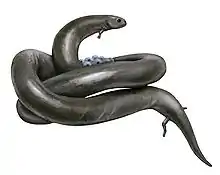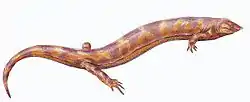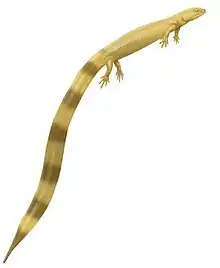Quasicaecilia
Quasicaecilia is an extinct genus of microsaur. It is known from the Early Permian of Texas in the United States. A single specimen is known, collected from the Texas Permian redbeds by Charles Hazelius Sternberg in 1917. It was originally identified as a specimen of the gymnarthrid microsaur Cardiocephalus. The skull is small, less than 2 centimetres (0.79 in) in length, and the otic capsule (a hollow region of bone encapsulating the inner ear) is very large in comparison to the rest of the skull. The skull of Quasicaecilia superficially resembles those of extant but unrelated caecilians, hence the genus name.[1] Quasicaecilia was assigned to the new family Brachystelechidae in 1991 along with the genera Batropetes and Carrolla.[2]
| Quasicaecilia Temporal range: Early Permian | |
|---|---|
| Scientific classification | |
| Kingdom: | |
| Phylum: | |
| Class: | |
| Subclass: | |
| Order: | |
| Suborder: | Microbrachomorpha |
| Family: | |
| Genus: | Quasicaecilia Carroll, 1990 |
| Species | |
| |
See also
- Prehistoric amphibian
- List of prehistoric amphibians
References
- Carroll, R. L. (1990). "A tiny microsaur: size constraints in Palaeozoic tetrapods" (PDF). Palaeontology. 33: 1–17. Archived from the original (PDF) on 2011-08-24.
- Carroll, R. L. (1991). "Batropetes from the Lower Permian of Europe- a microsaur, not a reptile". Journal of Vertebrate Paleontology. 11 (2): 229–242. doi:10.1080/02724634.1991.10011390.
This article is issued from Wikipedia. The text is licensed under Creative Commons - Attribution - Sharealike. Additional terms may apply for the media files.



